|
Introduction - The Dutch Coast The Netherlands is a densely populated low-lying country in which about 60 percent of the population lives in the coastal area. The country is bordered by the North Sea, Germany and Belgium. The southern part of the coast (between the Belgian border and Hoek van Holland, near Rotterdam) consists of the estuary of the rivers Rhine, Meuse and Scheldt. The coastline between Hoek van Holland and Den Helder is continuous, except for the mouth of the old river Rhine and the artificial sea defence structure "Hondsbossche Zeeweering". Between Den Helder and the German border lies the Dutch part of the Wadden Sea. The Dutch coast is part of a larger coastal system, stretching out from the north coast of France (cap Blanc Nez) to the Danish coast at Jut Land.
The low-lying nature of the Dutch coastal zone makes it particularly vulnerable to coastal flooding and erosion associated with storms and sea level rise. The large parts of the country that are below sea level are protected against flooding by a coastal defence structure consisting of natural and artificial units. For ages, the people living in this low-lying region faced the eternal struggle against the threats of the sea. For this reason, they have been preoccupied with land reclamation, polderization, dike construction and water level control out of sheer necessity. (Karel Van der Mullen, 2001). The Dutch inhabitation of the coastal zone has been facilitated by one of the most extensive coastal defence systems in the world in which dams, and dikes protect nearly one half of the 451 kilometres (280miles) of the coastline. From 1990, the coastal policy is to maintain the coastline with sand nourishment to prevent further loss of land. This policy has been successful so far. However, in future, problems may occur due to sea level rise and further urbanization of the coastal zone.
|
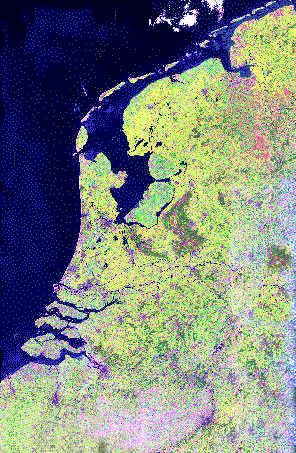
Satellite image of the Netherlands |
|
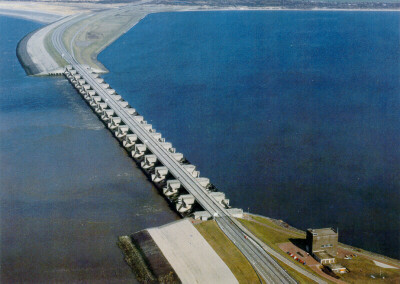
Discharge sluices in the Haringvliet dam. This dam blocks the Haringvliet, a former branch of the estuary of the Rhine, Meuse and Scheldt, from the North Sea. The discharge sluices are used to discharge excess water from the fresh water lake into the sea. Currently the government decided to let salt water intrude again on a small scale into the Haringvliet in order to restore the original ecosystem. | Government Type
The government of Netherlands is a constitutional monarchy with a national government led by a prime minister. The prime minister is assisted by a cabinet (or council of ministers). The legislative branch of government is bicameral, with a first chambers elected by provincial council (which is elected by popular vote) and a second chambers elected directly by popular vote. The Supreme Court leads the legal system. There are twelve provinces in the Netherlands and about 500 municipalities. Over the years the Dutch have become famous for the so-called polder model of management, which entails extensive consultation and active involvement of all the relevant actors in decision-making and overall management. With respect to coastal management, activities are initiated at the municipal level and water boards under supervision from the provincial government. The national government acts to supervise activities in a consistent manner. It also manages big rivers and national waters like the North Sea and also serves to resolve conflicts. |
How public participation started Public involvement in coastal management in The Netherlands did not take an entirely smooth historical route. In fact like in most other countries the people had to fight for this right themselves in a most decisive manner. Two major events are worth mentioning. The first is the plan drawn up by the provincial authorities of Friesland to connect the island of Ameland to the main land by means of two dams. This plan was important to the Dutch Ministry of Water management and Transport because the so called "Zuiderzeewerken", comprising the partial reclamation of the Zuyder Zee / IJsselmeer was near completion and was part of a more comprehensive plan which included the sea area north of IJsselmeer Dam (Afsluitdijk), i.e the Wadden Sea. However, people protested against the plans. Over 50,000 citizens and several organizations sent letters of protest to the regional and national authorities. The public involvement on a national scale became a serious problem especially for the Ministry. At the beginning of 1968, the Ministry of Water management and Transport proposed to establish a multi disciplinary commission to conduct a coordinated research into the basic advantages and disadvantages of total and partial reclamation. The study, which took four years, contained a wealth of information with a simple conclusion: no reclamation of the Wadden Sea but protection and conservation. The second event, which marked a turning point in the Dutch coastal policy especially as it concerns public influence on decision-making, was the plan proposed by the government to build a dam in the province of Zeeland that would totally block off the Eastern Scheldt from the North Sea. This plan was necessitated by safety and fear of flood, because in 1953 a dramatic storm surge inundated a large area of the south-western part of the Netherlands destroying many coastal settlements and agricultural land, and killing about 2000 people.
In effect the dam was supposed to serve as an affective barrier against future flood but would have also meant the destruction of the valuable ecosystem characteristic of the estuarine habitat. Again the public rose against this plan. Through letters with protests and protest marches the public got the government to re-evaluate the whole project. Later, the idea of a total blockade was set aside and instead, an open dam, which can be closed at extreme weather and North Sea conditions, was constructed. This project was favoured even though it cost about seventy times more than the original plan. It was principally the above cases that effectively set in motion chains of events that have caused the government to reassess the entire process of its environmental decision-making in favour of early stakeholder involvement. More as rule than as exception, the government ensures that the people are as widely consulted as possible especially in major decisions that could generate mass protests. Over the years, policies, strategies and experiences have grown in the issue of public participation in coastal management. |
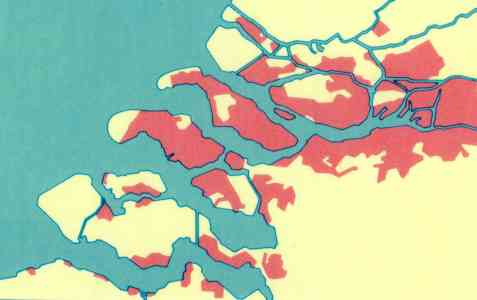
Overview
of the flooded area during the storm of 1953.
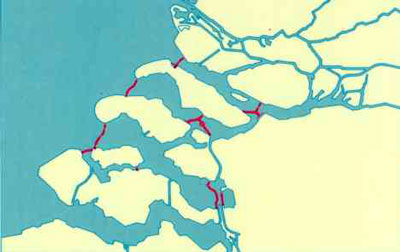
Overview
of closure dams constructed during the Delatworks.
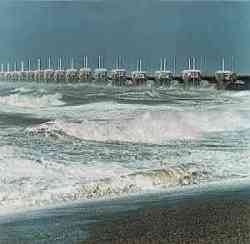
Eastern Scheldt storm surge barrier. |
|
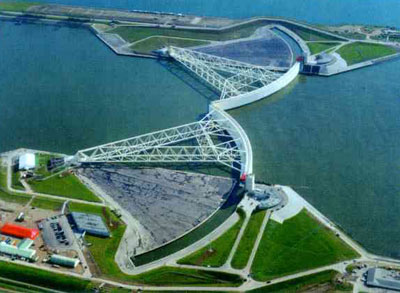
The
"Maeslantkering"
is the final protection work of the Deltaworks. Situated in the main access
channel of the Port of Rotterdam it is usually in open condition. It has
been designed to withstand a severe storm occurring once every 50 years.
|
Means of
public involvement in coastal management
Policies
Sharp distinctions
do not always exist between the policies and the strategies of public
participation in coastal zone management. For the purpose of this work
the public participation procedures that owe their existence to legal
and statutory requirement are tested as policies whereas those that
evolve more out of the initiatives of the policy planners and executioners,
NGOs, local people etc are considered under strategies.
Strategies
and Mechanisms
From
Consultation to Participation
The
NGO movement
The various
mechanisms for public participation in Europe are revealed in the European
Union Demonstration Programme on ICZM Participation in the ICZM
process: Mechanism and procedure needed p.98. In the Netherlands most
popular mechanisms are the following ones:
|